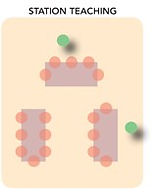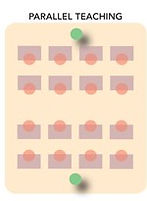
Co-teaching occurs when two or more educators collaborate on instruction. Normally this will consist of a general education teacher and a special education teacher or other sort of specialist. Both share the responsibility of instruction for a single group of students. When effective co-teaching is executed it can be a great way to help meet the needs of students with special disabilities leading to classroom inclusion. Co- teaching is only one of the many options that is available to help meet the needs of students. There are six different co-teaching approaches that are common instructional practices.
One Teach, One Observe:
With this approach, one teacher will lead the lesson and the other gathers data on the group of students to understand them better. This data can allow the educators to make better and more influential instructional decisions. With this approach, it is imperative that both teachers share the responsibility of teaching and observing equally. Therefore, both are credible when leading instruction.
Station Teaching:
In station teaching, there are three groups of students assigned. At two of these stations teachers are assigned to facilitate instruction, leaving one group to be student orientated. If students cannot work independently than a change can be made eliminating the last group.
Parallel Teaching:
Occasionally two teachers might find it to their advantage to split up a diverse class group and have each teacher instruct only half the class. With this style, each student has many more opportunities to participate. Each teacher can choose a different style of teaching and students can choose where best they feel they can learn.
Alternative Teaching:
Another option co-teachers can try is to have one teacher work with most of the class while the other will focus on a small group. Often, the small group is used to remediation but other options are also available. Enrichment can also work in small groups. Therefore, the small groups can also be for advanced students to present a challenge.
Teaming:
With this approach, teachers share leadership and instruction within the classroom. Each is engaged in classroom discussion and operations. Co- teachers who utilize this method find it one of the more energizing options; however, it takes a high amount of collaboration and compatibility between teachers to teach this way.
One Teach, One Assist:
In this co-teaching model, one teacher is leading the lesson while the other educator is quietly assisting individual students with assistance. The general education teacher can teach the lesson while the special education teacher or specialist walks around helping students with understanding or making sure they stay on task. With too frequent of use, students can become dependent.
*all co-teaching pictures Ed Weekly: http://www.edweek.org/media/2011/10/10/sb-nn-coteach-c1.jpg
Cooperative Teaching Models






Co Teaching Strategies
General Education Teacher : Marita Shingler
Special Education Teacher: Cindy Alexander
https://www.youtube.com/watch?v=6llQCG8QhBE
Co Teaching Examples
by: Allison Brewer
“This is a compilation of short videos taken during observations of the six different co teaching models.”
**Friend, Marilyn Penovich, and William D. Bursuck. Including Students with Special Needs: A Practical Guide for Classroom Teachers. 6th
ed. Boston: Allyn and Bacon, 1996. Print.